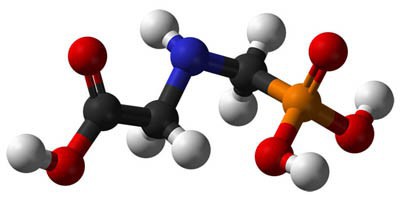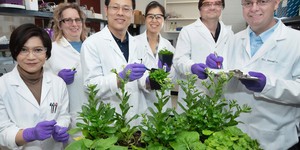Abstract
Farmers are constantly battling various types of weeds that compete with the crops they are trying to grow. One of the tools they use to combat unwanted plants is a chemical called glyphosate. Glyphosate is the active ingredient in Roundup, a widely used weed killer. In this plant biology science fair project, you will explore the factors that affect the activity of glyphosate.Summary
David Whyte, PhD, Science Buddies
Edited by Janet Nelsen, Monsanto Company Calgene Campus
- Roundup® is a registered trademark of Monsanto Technology, LLC.
- Popsicle® is a registered trademark of Good Humor-Breyers Ice Cream, which is a subsidiary of Unilever Supply Chain, Inc.

Objective
The objective of this plant biology science fair project is to determine how the dose and method of application affect the activity of a glyphosate-based weed killer, like Roundup®.
Introduction
If you wanted to find a chemical that would kill plants, but would not harm people, you might start by identifying processes that are critical for plants to grow, but that are not present in animals. One such process is the synthesis of these amino acids: phenylalanine, tyrosine and tryptophan. Plants need to make these amino acids "from scratch" in order to live. People, on the other hand, do not make these amino acids, because we get them from eating the plants. In fact, people do not even have the ability to make these amino acids because we lack the enzymes that are needed for their synthesis.
The chemical glyphosate kills plants by inhibiting the enzyme 5-enolpyruvylshikimate-3-phosphate synthase (EPSPS) (EE-nahl-py-ROO-vuhl-SHIH-kih-mate). This enzyme is critical for the synthesis of the amino acids phenylalanine, tyrosine, and tryptophan in plants.
 Image Credit: Wikipedia / Public domain
Image Credit: Wikipedia / Public domain
Figure 1. Chemical model of the glyphosate molecule. (Wikipedia, 2008.)
Glyphosate is transported from the leaves to the roots of treated plants. This is critical for its effectiveness. Because it is transported to the roots, it is able to actually kill the weed, rather than just damage the weed's leaves. Glyphosate is toxic to nearly all plants, not just weeds. If you are using it in your garden, you need to shield the plants that you want to grow from the spray.
It is possible to make plants resistant to the killing action of glyphosate using genetic modification of the plant's DNA. Monsanto Technology, the makers of Roundup, has created several "Roundup-ready" crops, including maize (corn), canola, soy, cotton, and alfalfa. These crops are made resistant to Roundup, and other glyphosate-based weed killers, by introducing a modified version of the EPSPS gene into the plants. This modified gene makes an enzyme that is slightly different than the "normal" enzyme. It still catalyzes the same biochemical processes as the normal enzyme, but it no longer binds glyphosate. The genetically modified plant is then able to grow in the presence of glyphosate because its ability to produce the amino acids phenylalanine, tyrosine, and tryptophan is not inhibited by the chemical. Spraying a field with glyphosate will kill weeds, but not the Roundup-ready genetically modified plants. In this plant biology science fair project, you will experiment with the factors that affect the plant-killing activity of glyphosate.
Terms and Concepts
- Amino acid
- Phenylalanine
- Tyrosine
- Tryptophan
- Enzyme
- Glyphosate
- Roundup
- 5-enolpyruvylshikimate-3-phosphate synthase (EPSPS)
- Transport
- Genetic modification
- Catalyst
- Control
Questions
- Based on your research, how did scientists at Monsanto find a version of the EPSPS enzyme that is resistant to glyphosate?
- Besides soy, what plants have been genetically modified to be resistant to glyphosate?
- What are the biochemical steps in the synthesis of the amino acids phenylalanine, tyrosine, and tryptophan by plants?
- As more crops are treated with glyphosate, would you expect the occurrence of glyphosate-resistant plants to increase? Why?
- What are some ways that a plant could develop resistance to glyphosate? Think about all of the steps that are essential for the chemical to work, and how the plant might develop resistance at each step.
- What are the roles of the other chemicals that are mixed in with glyphosate?
Bibliography
- Shaner, D. (2006, December 12). An Overview of Glyphosate Mode of Action: Why Is It Such a Great Herbicide?. Retrieved February 12, 2009.
- Peel, M.D. (2001, October). A Basic Primer on Biotechnology. Retrieved February 12, 2009.
- Wikipedia Contributors. (2009, February 5). Enzyme Inhibitor. Wikipedia: The Free Encyclopedia. Retrieved February 12, 2009.
- Monsanto. (2005, June). Backgrounder: History of Monsanto's Glyphosate Herbicides. Retrieved March 17, 2009.
Materials and Equipment
- Roundup Weed and Grass killer, any ready-to-use formulation (i.e. not a concentrated formulation that has dilution directions). Other brands containing glyphosate can be used instead.
- Plants (6 trays with 15 or more plants per tray). Choose plants with well-defined leaves, as one of the tests involves examining the effect of the spray on a per-leaf basis. All of the plants in the tray should be roughly the same size.
- Popsicle® sticks (24)
- Permanent marker
- Spray bottles, empty, and should hold approximately 500 mL (5), available from Carolina Biological, item #: 665565
- Masking tape
- 500 mL graduated cylinder, available from Carolina Biological, item #: 721605
- Cardboard, medium-sized piece to protect surrounding plants when spraying the herbicide
- Optional: Disposable gloves. Can be purchased at a local drug store or pharmacy, or through an online supplier like Carolina Biological Supply Company. If you are allergic to latex, use vinyl or polyethylene gloves.
- Lab notebook
- Graph paper
Disclaimer: Science Buddies participates in affiliate programs with Home Science Tools, Amazon.com, Carolina Biological, and Jameco Electronics. Proceeds from the affiliate programs help support Science Buddies, a 501(c)(3) public charity, and keep our resources free for everyone. Our top priority is student learning. If you have any comments (positive or negative) related to purchases you've made for science projects from recommendations on our site, please let us know. Write to us at scibuddy@sciencebuddies.org.
Experimental Procedure
In order to experiment with glyphosate, you will need to kill some plants. There are several ways to obtain the plants: you can buy them as trays at a nursery, you can grow them from seed, or you can work with weeds in your yard. The procedure below involves working with plants bought at a nursery. Be sure to care for the plants not being used in current trials so they are healthy when you are ready to use them.
Determining Effects of Varying Glyphosate Concentrations
In the first section, you will determine how the concentration of glyphosate affects its activity. This test is called a dose-response test. Caution: Perform this test in a well-ventilated area.
- Label the plants 1–15, using a permanent marker to write on the Popsicle sticks and then inserting them in the soil of each plant.
- Label the empty spray bottles 1–5 with the permanent marker and masking tape.
- Adjust and test the bottle nozzles so they are all set at approximately the same spray setting—not a singe stream, but not a spray that just produces a fine mist either.
-
Put on your disposable gloves and fill the bottles as follows:
- Bottle # 1: Add 400 mL of water.
- Bottle # 2: Add 100 mL of Roundup and 300 mL of water (25 percent strength).
- Bottle # 3: Add 200 mL of Roundup and 200 mL of water (50 percent strength).
- Bottle # 4: Add 300 mL of Roundup and 100 mL of water (75 percent strength).
-
Bottle # 5: Add 400 mL of Roundup (100 percent strength).
- Use the spray bottle for # 5 rather than the bottle the Roundup came in so that all of the spray nozzles are the same.
-
The plants will be sprayed with the following solutions:
- Plants 1, 2, 3: With water only
- Plants 4, 5, 6: With the 25 percent solution
- Plants 7, 8, 9: with the 50 percent solution
- Plants 10, 11, 12: With the 75 percent solution
- Plants 13, 14, 15: With the 100 percent solution
-
Following the directions on the Roundup bottle, begin by spraying plants 13, 14, and 15 with the full-strength Roundup (the 100 percent solution).
- Be careful not to spray neighboring plants. Use the cardboard to block the untreated plants.
- Using the same amount of spray on each plant, repeat the same spray application for the other concentrations. Spray enough that the treated leaves are covered with liquid.
-
In your lab notebook, record the effect of the glyphosate on the plants each day for 10 days.
- You can observe the plants for a shorter or longer period of time than 10 days. Vary the time, if it seems appropriate.
- Provide light and water to the untreated plants so they remain healthy until you are ready for the remainder of your trials.
- Use a scale from 1–5, with 1 being "very healthy" and 5 being "dead."
- Use your judgment about the definition of the plant's health; just be consistent with all of the plants.
- Record the plant's health score (1 to 5) in your lab notebook as a reference for all the tests.
- Take photographs or draw pictures of the plants at each stage of health.
-
Graph the concentration (x-axis) vs. the time (y-axis) it took for the plant to die.
- Graph each plant separately.
- Also graph the average results for each group.
- Repeat steps 1–9, for a total of three trials. Use clean materials and new plants each time.
Determining Effects of Spraying Varying Surface Areas with Glyphosate
In this section, you will determine the minimum area that needs to be treated in order to kill the plant. This is a test of exposure (surface area) vs. effect.
- Label the plants 16–30, using a permanent marker to write on the Popsicle sticks and then inserting them in the soil of each plant.
-
The plants will be sprayed as follows:
- Plants 16, 17, 18: With water only
- Plants 19, 20, 21: One-leaf coverage, full-strength Roundup
- Plants 22, 23, 24: 25 percent coverage, full-strength Roundup
- Plants 25, 26, 27: 50 percent coverage, full-strength Roundup
- Plants 28, 29, 30: 100 percent coverage, full-strength Roundup
- Count the leaves of each plant to determine the number of leaves that should be sprayed to achieve 25 percent and 50 percent coverage. For example, it the plant has 20 leaves, spray just 5 of them for 25 percent coverage. For 100 percent coverage, spray all of the leaves. Record all data in your lab notebook.
- Protect untreated leaves from mist. Don't spray if there is a breeze that could spread the liquid.
- Spray plants 16, 17, and 18 with water. Spray the whole plant. Each leaf you spray should be covered with liquid. This is the control group.
- Continue spraying the rest of the plants, as indicated in step 2. Spray the same amount on each leaf. Each leaf you spray should be covered with liquid.
- Observe the plants for 10 days.
- Provide water and light to all of the plants.
- For each plant, record the time and health score, as you did in the first section, each day for 10 days. Vary the time if it seems appropriate.
- Graph the results, with the area covered (25 percent, 50 percent, etc.) on the x-axis and the time on the y-axis.
- Also graph the time to first signs of toxicity and the time to death for each plant.
- Repeat steps 1–11, with fresh plants, for a total of three trials.
Ask an Expert
Global Connections
The United Nations Sustainable Development Goals (UNSDGs) are a blueprint to achieve a better and more sustainable future for all.
Variations
- To model the effect of rain after application of the Roundup, wash off the Roundup at various times. How long before the effects of the chemical cannot be reversed by washing?
- Glyphosate is reported to be inactivated when it comes into contact with the soil. Devise a way to test this.
- Devise an experiment to test whether the transport of glyphosate to the plant's roots is temperature-dependent.
- Does it matter what time of day you spray the plants? Plants perform different biochemical processes during the day and night.
Careers
If you like this project, you might enjoy exploring these related careers:
Related Links
- Science Fair Project Guide
- Other Ideas Like This
- Plant Biology Project Ideas
- Agricultural Technology Project Ideas
- My Favorites










